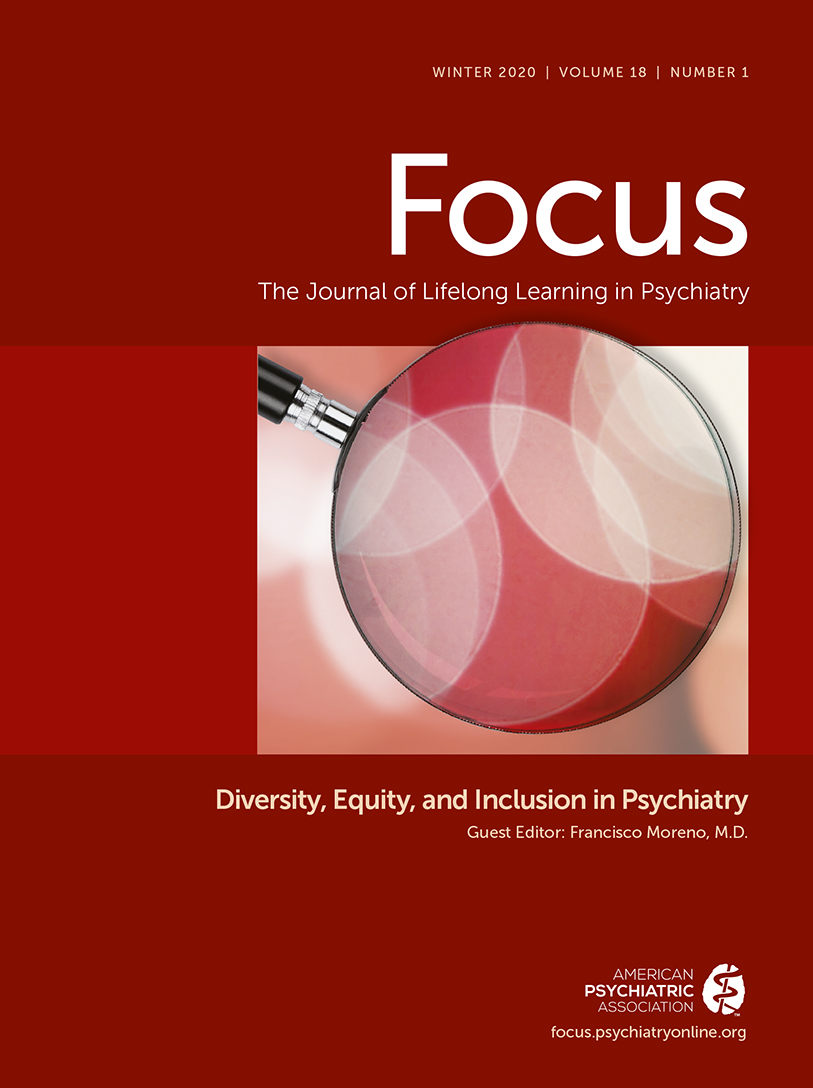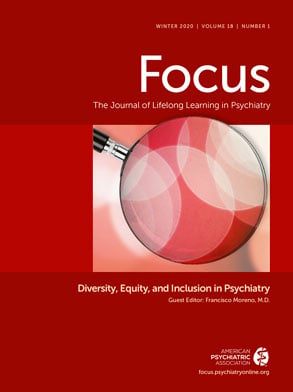Culture shapes every aspect of patient care in psychiatry, influencing when, where, how, and to whom patients narrate their experiences of illness and distress, the patterning of symptoms, and the models clinicians use to interpret and understand symptoms in terms of psychiatric diagnoses. Culture also shapes patients’ perceptions of care, including what types of treatment are acceptable and for how long. Even when patients and clinicians share similar ethnic or linguistic backgrounds, culture affects care through other influences on identity, such as those attributable to gender, age, class, race, occupation, sexual orientation, and religion/spirituality. Because cultural contexts and expectations frame the clinical encounter for every patient, and not just those from underserved minority groups, cultural formulation is an essential component of any comprehensive psychiatric assessment.
Content of the Core CFI
Having discussed the development process of the CFI, this article now turns to its content. The core CFI comprises four sections. The first section, known as the “Cultural Definition of the Problem,” includes the first three questions. Question 1 is “What brings you here today?” Although this question may not appear to have a specific cultural focus, its open-ended nature is intended to elicit the patient’s view of core problems and concerns. The intent is to begin the clinical encounter with the issues that matter most to patients rather than to prioritize biomedical signs and symptoms (
11). A prompt is included if the individual gives few details or only mentions biomedical terms: “People often understand their problems in their own way, which may be similar to or different from how doctors describe the problem. How would you describe your problem?” This prompt empowers patients to share their experiences of distress in narrative form without concern for medical accuracy. Question 2 (“Sometimes people have different ways of describing their problem to their family, friends, or others in their community. How would you describe your problem to them?”) situates the patient’s description of the problem within the social network, recognizing that culture exists in the ties between people and shapes how information is processed and communicated differently based on audience, including patients and clinicians (
12). Question 3 (“What troubles you most about your problem?”) obtains perceptions of illness severity in order to discuss impairments from the patient’s perspective.
Questions 4–10 compose the second section, “Cultural Perceptions of Cause, Context, and Support.” Question 4 (“Why do you think this is happening to you? What do you think are the causes of your [PROBLEM]?”) explores the patient’s meaning of illness. This information can be useful for treatment planning. For example, patients who perceive their illness to be caused by difficult interpersonal relationships may not want to try medication, whereas patients who believe that their illness is biologically inherited may be more receptive to pharmacotherapy (
13). The “[PROBLEM]” placeholder is designed for clinicians to use the patient’s terms and phrases throughout the rest of the interview in order to build rapport and linguistically enter the patient’s life world (
14). Language matching is one explicit communication strategy that the CFI promotes to reduce cultural misunderstandings between patients and clinicians. Patients may use biomedical vocabulary such as “depression” or common vernacular terms such as “the baby blues” in discussing their experiences, and clinicians can use such terms in the placeholder. A prompt can help patients consider a range of causes for more complete answers: “Some people may explain their problem as the result of bad things that happen in their life, problems with others, a physical illness, a spiritual reason, or many other causes.” The prompt normalizes the possibility that differences may exist between patient and clinician perceptions of illness causes without prioritizing any single meaning. Question 5 (“What do others in your family, your friends, or others in your community think is causing your [PROBLEM]?”) asks the patient to consider what members of the social network understand as the cause of illness. Questions throughout the CFI that ask the patient to think about topics from the perspectives of close associates are concrete ways in which the CFI operationalizes the
DSM-5 definition of culture as transmitted among groups. The CFI assesses all four OCF domains. Questions 1–5 address many of the elements of a cultural assessment mentioned in OCF domain B, titled “Cultural Conceptualizations of Distress” in
DSM-5, including “cultural constructs that influence how the individual experiences, understands, and communicates his or her symptoms or problems to others” (p. 750). Other elements of OCF domain B are tapped in later CFI questions on coping (Question 11) and help seeking (Questions 12–15).
Domain C of the OCF, “Psychosocial Stressors and Cultural Features of Vulnerability and Resilience,” is addressed in CFI Questions 6 and 7 on supports and stressors. Question 6 asks “Are there any kinds of support that make your [PROBLEM] better, such as support from family, friends, or others?,” whereas Question 7 asks “Are there any kinds of stresses that make your [PROBLEM] worse, such as difficulties with money, or family problems?” Both of these questions can help patients and clinicians appreciate how other individuals and situations may improve or worsen the problem in expanding the focus of the interview to include the social contexts of illness (
15).
Questions 8–10 tackle domain A of the OCF, “Cultural Identity of the Individual.” They serve as a transition to how the patient’s cultural identity relates to the problem being presented. Question 8 begins with an introduction to activate patients toward considering diverse sources of cultural identity: “Sometimes, aspects of people’s background or identity can make their [PROBLEM] better or worse. By background or identity, I mean, for example, the communities you belong to, the languages you speak, where you or your family are from, your race or ethnic background, your gender or sexual orientation, or your faith or religion.” This introduction provides examples of identities that may be salient for the patient. Question 8 (“For you, what are the most important aspects of your background or identity?”) then poses a question directly to the patient to encourage a patient-centered approach of eliciting and understanding this important cultural information. This method releases clinicians from the burden of guessing the patient’s identity, which has sometimes characterized previous and now outmoded models of cultural competence (
4). Instead, the CFI opts for a patient-centered approach to culturally competent care. Question 9 (“Are there any aspects of your background or identity that make a difference to your [PROBLEM]?”) asks patients to assess the relationship between cultural identity and the problem presented. This question can prevent clinicians from assuming that a particular form of care is needed for a certain social group (e.g., a racial or ethnic community) without first considering its relevance to individual patient care. Question 10 (“Are there any aspects of your background or identity that are causing other concerns or difficulties for you?”) moves from the clinical setting to the patient’s social context as another way of situating the illness within general life experiences. Problems with migration, immigration status, gender roles, or intergenerational conflict may be mentioned as possible answers and can provide valuable information on the extent to which resources (
2) are available to patients as clinicians devise treatment plans.
Questions 11–13 compose the third CFI section, “Cultural Factors Affecting Self-Coping and Past Help-Seeking.” The objective of this section is to evaluate which interventions—at the individual, community, or clinical levels—have improved or worsened the patient’s condition. Question 11 (“Sometimes people have various ways of dealing with problems like [PROBLEM]. What have you done on your own to cope with your [PROBLEM]?”) clarifies the individual’s forms of self-coping. Question 12 moves beyond the individual to address help seeking at the community level, either with or without receipt of biomedical services: “Often, people look for help from many different sources, including different kinds of doctors, helpers, or healers. In the past, what kinds of treatment, help, advice, or healing have you sought for your [PROBLEM]?” A prompt for this question illuminates which types of help may be mobilized for current treatment planning: “What types of help or treatment were most useful? Not useful?” Question 13 can elucidate barriers in accessing care: “Has anything prevented you from getting the help you need?” Another prompt follows to help clinicians consider the range of resources for the current illness episode: “For example, money, work or family commitments, stigma or discrimination, or lack of services that understand your language or background?”
The final three questions constitute the fourth and final CFI section, “Cultural Factors Affecting Current Help Seeking.” Question 14 transitions from the past to the present illness episode: “Now let’s talk some more about the help you need. What kinds of help do you think would be most useful to you at this time for your [PROBLEM]?” The goal of this question is to elicit the patient’s perceived needs and expectations of help. Question 15 reviews treatment preferences according to members of the patient’s social network: “Are there other kinds of help that your family, friends, or other people have suggested would be helpful for you now?” These questions complete the assessment of patients’ cultural views of help seeking and self-care described in domain B of the OCF.
Question 16 begins with an open-ended statement before a direct question to the patient in contemplating perceived similarities and differences in the current patient-clinician relationship: “Sometimes doctors and patients misunderstand each other because they come from different backgrounds or have different expectations. Have you been concerned about this and is there anything that we can do to provide you with the care you need?” The goal of this question is to anticipate concerns and resolve potential conflicts while putting domain D of the OCF into practice. Under this fourth domain, “Cultural Features of the Relationship Between the Individual and the Clinician,” the CFI suggested:
Identify differences in culture, language, and social status between and individual and clinician that may cause difficulties in communication and may influence diagnosis and treatment. Experiences of racism and discrimination in the larger society may impede establishing trust and safety in the clinical diagnostic encounter. Effects may include problems eliciting symptoms, misunderstanding of the cultural and clinical significance of symptoms and behaviors, and difficulty establishing or maintaining the rapport needed for an effective clinical experience.
The goal of this question is to help patients identify differences that could cause difficulties in communicating with providers. A strong therapeutic alliance is crucial to diagnostic accuracy and treatment engagement, and this question can signal to patients that providers are willing to establish trust and safety. After this question, clinicians can proceed to the standard assessment, having begun the encounter by prioritizing the patient’s point of view.

